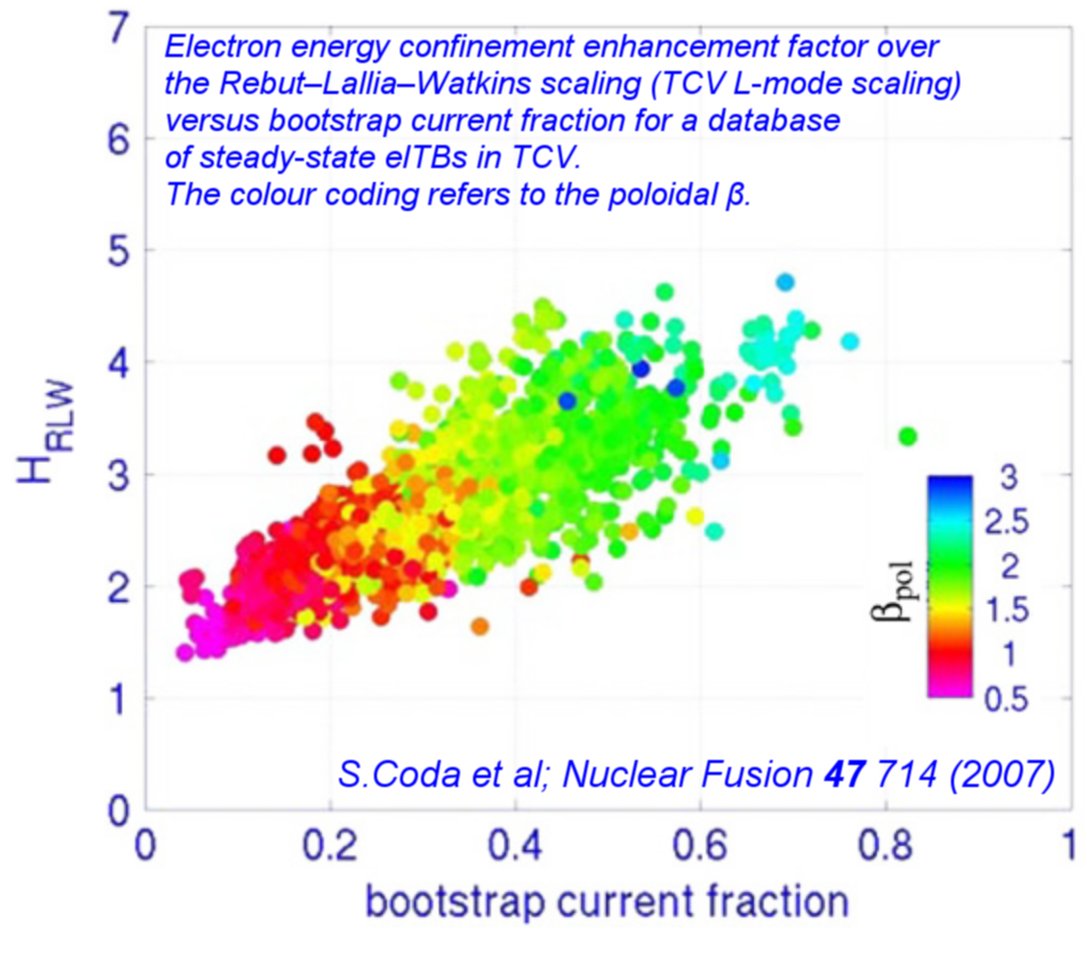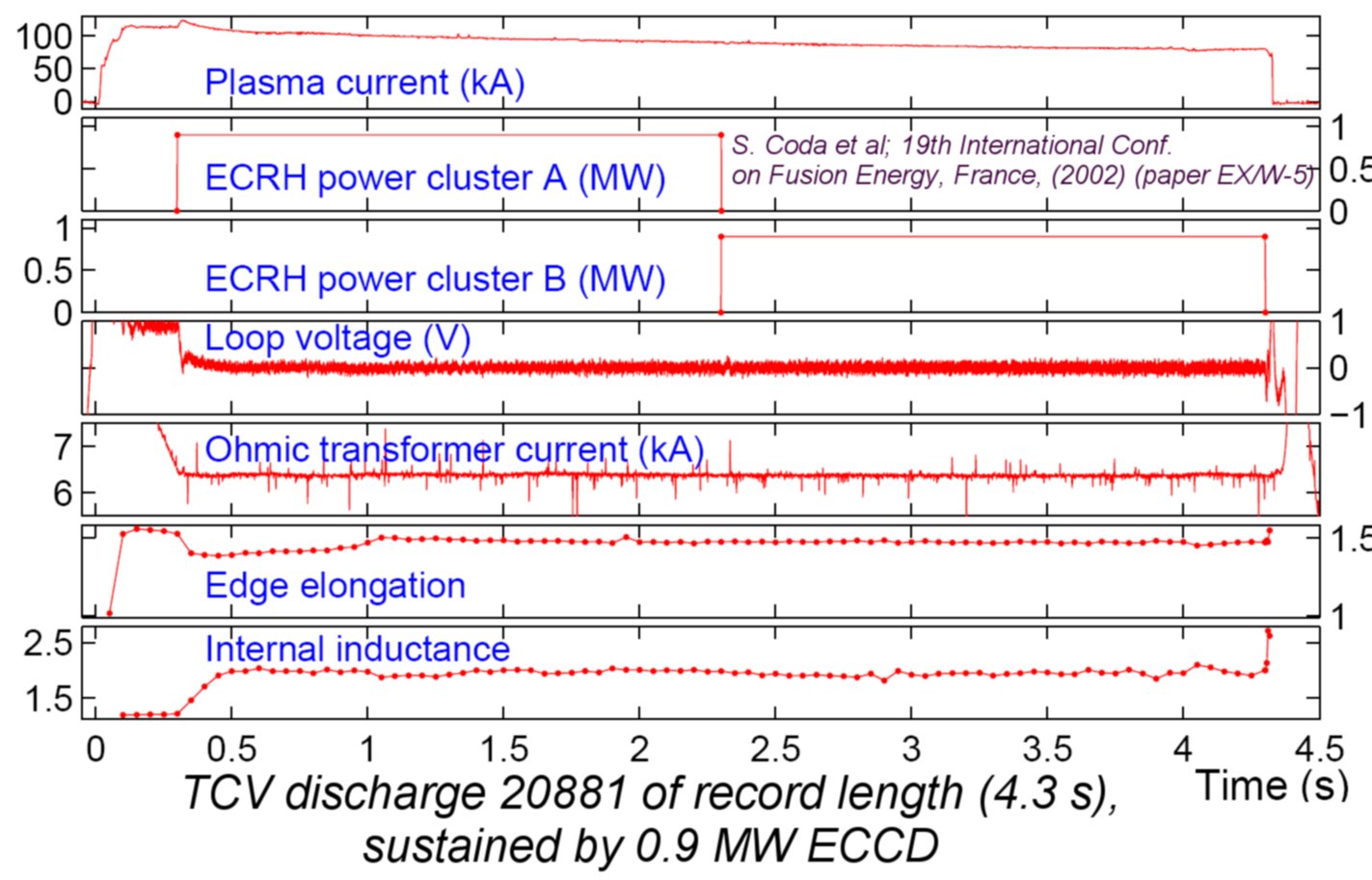Motivation
One of the modes of operation being considered for ITER steady-state discharges is the so-called advanced tokamak scenario.
It relies on the attainment of a high non-inductive plasma current component, and in particular a high internally generated bootstrap current fraction.
As strong pressure gradients are needed to drive large bootstrap currents, advanced tokamak scenarios require improved core confinement. The generation of ITBs is one mechanism that can provide the needed gradients.

TCV experiments contribute to advanced tokamak scenarios research and include:
- Development of fully non-inductive CD scenarios
- eITB formation studies
- Development of high fraction bootstrap current discharges.
Main results:
- TCV has produced discharges in which the current is entirely self-generated by the plasma, via intense ECH-ECCD. The bootstrap current fraction was increased up to 100%.
Two different methods were employed to achieve this result:
- High-power EC waves at the second harmonic are launched perpendicularly to the magnetic field during the initial plasma current ramp-up. In such injection geometry, waves do not drive current but generate strong eITBs by the transient negative central magnetic shear that develops in the current penetration phase. The Ohmic flux swing is zeroed immediately after the initial breakdown, cutting off the external plasma current source. Under appropriate conditions, the plasma then evolves spontaneously towards a stationary quiescent state, a stability point of the internal bootstrap feedback loop, characterized by a narrow eITB. Once the stable state is reached, the discharge remains stationary over the time scale of a TCV pulse (1–2 s).
- At first, a standard stationary non-inductive eITB is generated by off-axis co-ECCD. Counter-ECCD is then gradually added until the driven current density is nominally zero everywhere. The obtained quasi-stationary state indeed holds on a 100% bootstrap fraction since the co- and counter- EC-driven current cancel each other out.
- V.S.Udintsev et al; Global plasma oscillations in electron internal transport barriers in TCV; Plasma Physics and Controlled Fusion 50 124052 (2008) DOI:10.1088/0741-3335/50/12/124052
- S.Coda et al; The physics of electron internal transport barriers in the TCV tokamak; Nuclear Fusion 47 714 (2007) DOI:10.1088/0029-5515/47/7/023
- S.Coda, T.P.Goodman, M.A.Henderson, O.Sauter, R.Behn et al.; High-bootstrap, noninductively sustained electron internal transport barriers in the Tokamak a Configuration Variable; Phys. Plasmas 12, 056124 (2005); DOI:0.1063/1.1896953
- M.A.Henderson et al; Control of electron internal transport barriers in TCV; Plasma Phys. Control. Fusion 46 A275 (2004) DOI:10.1088/0741-3335/46/5A/030
- M.A.Henderson et al; Recent results from the electron cyclotron heated plasmas in Tokamak a Configuration Variable (TCV); Phys. Plasmas 10, 1796 (2003); DOI:10.1063/1.1562167
- Y.R.Martin et al; Accessibility and properties of ELMy H-mode and ITB plasmas in TCV; Plasma Phys. Control. Fusion 45 A351 (2003) DOI:10.1088/0741-3335/45/12A/023
-
 S. Coda et al; Electron Cyclotron Current Drive and Suprathermal Electron Dynamics in the TCV Tokamak; 19th International Conference on Fusion Energy, Lyon, France, (2002) ( paper EX/W-5 )
S. Coda et al; Electron Cyclotron Current Drive and Suprathermal Electron Dynamics in the TCV Tokamak; 19th International Conference on Fusion Energy, Lyon, France, (2002) ( paper EX/W-5 ) - J-M.Moret et al; ECH physics and new operational regimes on TCV; Plasma Phys. Control. Fusion 44 B85 (2002) DOI:10.1088/0741-3335/44/12B/307
- O.Sauter et al; Steady-state fully noninductive operation with electron cyclotron current drive and current profile control in the tokamak a configuration variable (TCV); Phys. Plasmas 8, 2199 (2001); DOI:10.1063/1.1355317
- Z.A.Pietrzyk, C.Angioni, R.Behn, S.Coda, T.P.Goodman, M.A.Henderson, F.Hofmann, and O.Sauter; Long-Pulse Improved Central Electron Confinement in the TCV Tokamak with Electron Cyclotron Heating and Current Drive; Phys. Rev. Lett. 86, 1530–1533 (2001) DOI:10.1103/PhysRevLett.86.1530
- O.Sauter et al; Steady-State Fully Noninductive Current Driven by Electron Cyclotron Waves in a Magnetically Confined Plasma; Phys. Rev. Lett. 84, 3322–3325 (2000) DOI:10.1103/PhysRevLett.84.3322
- S.Coda et al; High-power ECH and fully non-inductive operation with ECCD in the TCV tokamak; Plasma Phys. Control. Fusion 42 B311 (2000) DOI:10.1088/0741-3335/42/12B/323
PhD theses:
- C.Zucca, O.Sauter (Dir.); Modeling and control of the current density profile in tokamaks and its relation to electron transport; EPFL, Lausanne, 2009. doi:10.5075/epfl-thesis-4360
- E.Fable, O.Sauter (Dir.); Experimental and theoretical study of particle transport in the TCV tokamak; EPFL, Lausanne, 2009. doi:10.5075/epfl-thesis-4334
Key group members